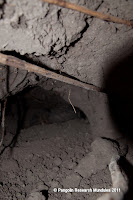A large pangolin, we named ‘Okulunu’ had been tagged on 2nd August 2011 with an RF transmitter and released in Mundulea, see previous post . Soon afterwards it disappeared from our ‘radar’, its signal being lost for more than two months. On Paul’s return to Mundulea for field work, he fortuitously picked up the signal again near dusk on October 17th from the access road to the Reserve, about 8km from its last release location. The signal was followed that evening about 300m to a nearby Aardvark burrow in a grey sandy area where it was photographed asleep on its side 2-3m deep in the den. Unfortunately the following day, perhaps because of our human scent we left behind, or because pangolins move from den to den, Okulunu had left the burrow and its signal was lost again.
(photos courtesy of Emiel de Lange)
Paul spent the next three weeks in October 2011 trying to pick up Okulunu's signal again without success and also hunting for the RF signal from another pangolin, named Kasupi which had been released on March 29th 2011 and tracked for about two weeks (select links for earlier posts). Kasupi seemed to have the habit of daytime foraging, which should have made the hunt easier. However, despite climbing all the hills in the Southern part of the reserve and systematically surveying on foot all of the area where Kasupi had last settled, looking with a flashlight down Aardvark holes that had been freshly disturbed, and checking on nearby frequencies in case the transmissions had wandered, its signal was not rediscovered. Unfortunately, the conclusion is that Kasupi's RF tag has probably ceased to function, possibly because of fracture at the aerial joint, where moisture might have entered the casing (see previous post). During all this searching, fresh traces of other pangolins' activity were observed in the Reserve, but finding any untagged pangolin is really a matter of chance.


No comments:
Post a Comment